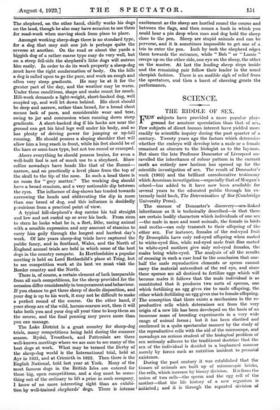THE SHEEP-DOG AND HIS WORK.
TN order to see a sheep-dog work at its best, one -I- should have a day with a hill-shepherd when he is out gathering his hundreds of woolly charges which pasture on the steep mountain slopes. Different types of dogs are used by shepherds, drovers, and butchers. Thus we find rough and smooth-coated collies, Old English sheep-dogs and various crosses or curs. The drover and the butcher find employment for their dogs on the roads or when loading or unloading stock at a railway. siding.- The shepherd, on the other :hand, chiefly works his dogs on the land, though he also may-have occasion to use them for road-work when moving stock from place to place.
Amongst working sheep-dogs there is no standard type, for a dog -that may suit one job is perhaps quite the reverse at another. On the road .or about the yards a biggish dog of a rather. coarse type may do very well, but on a steep fell-side the shepherd's lithe dogs will outrun him eagily. In order to do its work properly a sheep-dog _must have the right conformation of body. On the hills a dog is called upon to go the pace, and work on rough and often very steep gradients. He may be at it for the greater part of the day, and the weather may be warm. Under these conditions, shape and make count for much. Hill-work demands a light-weight, short-backed dog, well coupled up, and well let down behind. His chest should be deep and narrow, rather than broad, for a broad chest means lack of pace, and considerable wear and tear, owing to jar and concussion when running down steep gradients. A short-backed dog if his hocks are near the ground can get his hind legs well under his body, and so has plenty of driving power for jumping or up-hill running. He should possess a sloping shoulder that will allow him a long reach in front, while his feet should be of the hare or semi-hare type, but not too round or cramped.
Above everything he should possess brains, for even a well-built fool is not of much use to a shepherd. Show collies nowadays have heads like that of the Borzoi— narrow, and on practically a level plane from -the top of the skull to the tip of the nose. In such a head there is no room for " grey matter." The working dog should .have .a broad cranium, and a very noticeable dip between the eyes. The influence of dog-shows has tended towards -narrowing the heads and obliterating the dip in more than one breed of dog, and this influence is decidedly p3rnicious from a practical point of view.
A typical hill-shepherd's dog carries his tail straight and low and not curled up or over his back. From stem 'to stern he looks what he is, a fleet, lithe, racing animal with a sensible expression and any amount of stamina to carry him gaily through the longest and hardest day's work. Of late years sheep-dog trials -have captured the public fancy, and in. Scotland, Wales, and the -North of -England _annual -trials are held in which some of the best dogs in the country compete. In Hertfordshire a popular meeting is held on Lord 'Rothschild's place at ,Tring, but to see competition work at its best we must -visit the Border country and the 'North.
There is, of course, a. certain element of luck inseparable -from all such competitions, for the sheep provided for the occasion differ considerably-in temperament and behaviour. you chance to get three sheep of docile disposition, and your dog is up to his work, it may not be difficult to make a perfect round of the course. On the other hand, if your,sheep are of the wild. harum-scarum sort, then it will take both you and your dog-all your time to keep them on the course, and the final penning may prove more than you can manage.
The Lake District is a great country for sheep-dog trials, many competitions being held during the summer season. Rydal, Troutbeck, and Patterdale are three well-known meetings where we are sure to see many of the best dogs at work. What may be termed the Derby of the sheep-deg world is the International trial, held at Ayr in 1921, and at Criceieth in 1922. Then there is the English National, held last year at York. Many of the most famous dogs in the British -Isles are entered for these big, open competitions, and a dog must be some- thing out of the ordinary to lift a prize in such company. I know of no more interesting sight than an exhibi- tion .by well-trained ,shepherds' dogs. There is intense excitement as the sheep are hustled round the course and between the flags, and then comes a hush in which you could hear a pin drop when man and dog hold the sheep close to the pen. Sheep are stupid animals and can be perverse, and it is sometimes impossible to get one of a trio to enter the pen. Inch by inch the shepherd edges them towards the entrance, while " Bob " or " Lassie " creeps up on the other side, one eye on the sheep, the other on the master. At last the leading sheep steps inside and the remaining pair follow their leader in the usual sheepish fashion. There is an audible sigh of relief from the spectators, and then a burst of cheering greets the performance.



































 Previous page
Previous page